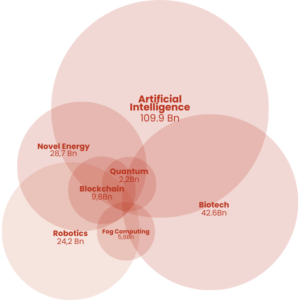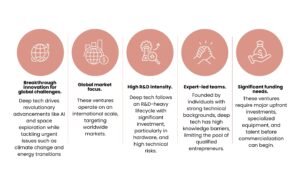
The adoption of deep tech innovations to the agrifood sector is no longer optional—it is a necessity. Technologies like artificial intelligence, robotics, and
quantum computing have the potential to improve efficiency, sustainability, and resilience in food production. Additionally, the convergence of these technologies has wider implications for returns on investment.
Frontier Technologies Platforms Convergence and Investment in 2024
Deep Tech innovations reshaping the Agrifood industry and driving unprecendented investment returns.
These technologies have in common:
Overall, these technologies promise higher returns to investors than traditional technology models, producing an average net IRR of 17 percent compared to 10 percent for traditional tech funds, which is due to a lower competition, significantly qualified founders, larger addressable markets or a higher potential for IP protection.
1 Artificial Intelligence (AI)
The rise of neural networks is expected to be even more transformative than electrification, with the potential to generate trillions in economic value. As this technology advances, it will require an unprecedented level of computational power, with AI-specialized hardware becoming the backbone of next-generation cloud data centers responsible for developing and deploying AI models. For consumers, this shift will introduce a network of AI-powered smart devices that seamlessly integrate into daily life, reshaping how people choose and consume food and ultimately how they live.
2 Robotics
Powered by artificial intelligence, humanoid robots are expected to work alongside humans, seamlessly navigating existing infrastructure and transforming how food products are manufactured, sold, and even how we live at home. At the same time, 3D printing is driving the digitization of manufacturing, enhancing the precision and performance of end-use parts while strengthening supply chain resilience. Meanwhile, the world’s fastest robots—reusable rockets—are lowering the cost of launching satellite constellations, enabling continuous global connectivity and advanced Earth observation. As a rapidly evolving innovation platform, robotics has the potential to dramatically reduce transportation costs and times, streamline manufacturing complexity with 3D food printers, and minimize physical labor with AI-driven automation. In agriculture, robotic harvesters, autonomous tractors, and AI-powered drones are addressing labor shortages and inefficiencies, enhancing productivity, and enabling precise, data-driven farming operations.
3 Multi-Omics
The cost of gathering, sequencing, and analyzing digital biological data is rapidly decreasing, unlocking new possibilities in agriculture and food science. Multi-omic technologies—spanning genomics, proteomics, and epigenomics—offer deeper insights into biological systems, enabling advancements in crop resilience, nutritional optimization, and food safety. These technologies help develop improved formulations for nutritional, organoleptic, and shelf-life properties while also providing insights into their effects on human health. In silico approaches further accelerate progress by modeling complex biological interactions, optimizing food production, and enhancing precision agriculture. However, large-scale implementation remains a challenge, requiring collaboration between startups, corporations, and investors to bridge the gap between scientific breakthroughs and real-world applications in the food and agriculture industries.
4 Quantum computing and quantum sensors
Quantum computing is emerging as a transformative tool in agrifood, offering unprecedented computational power to solve complex problems. This technology has the potential to optimize molecular simulations for proteins, accelerate the development of climate-resilient crops, and refine supply chain logistics at a granular level. While still in its infancy, early adopters of quantum computing in agrifood will gain a competitive advantage by unlocking data-driven insights previously beyond reach.
5 Fog computing
The growing network of IoT-enabled sensors is generating vast amounts of data across food production, processing, and distribution. However, real-time decision-making remains a challenge due to data transmission bottlenecks. Edge and fog computing address this issue by enabling localized data processing, reducing latency, and improving responsiveness. From precision irrigation systems to automated quality control in food factories, these technologies are critical in making agrifood systems smarter and more efficient.
6 Blockchain
Beyond transparency, blockchain will enable greater decentralization of participants, leading to changes in financial flows. It will introduce smart wallets and stablecoins—new cryptocurrencies linked to commodities, facilitating commodity trading. Smart contracts will automate transactions, ensuring transparency and traceability. Blockchain will provide a secure and immutable record of the journey of food from farm to table, enhancing consumer trust, meeting regulatory requirements, and reducing the risk of fraud.
7 Novel Energy
New food production models, driven by technology-intensive resources, will require stable and efficient energy sources. Advances in energy storage, including next-generation batteries, fusion technologies, and alternative energy solutions, will support off-grid agricultural operations, reduce reliance on fossil fuels, and enhance the resilience of food supply chains.
The convergence of deep tech innovations in agrifood presents a pivotal opportunity for startups, R&D centers, corporations, and investors. As global food security challenges intensify and sustainability demands grow, early adopters of these technologies will gain a significant competitive advantage. For corporations, collaborating with research institutions and investing in deep tech startups is no longer just an innovation strategy—it is becoming a necessity.


